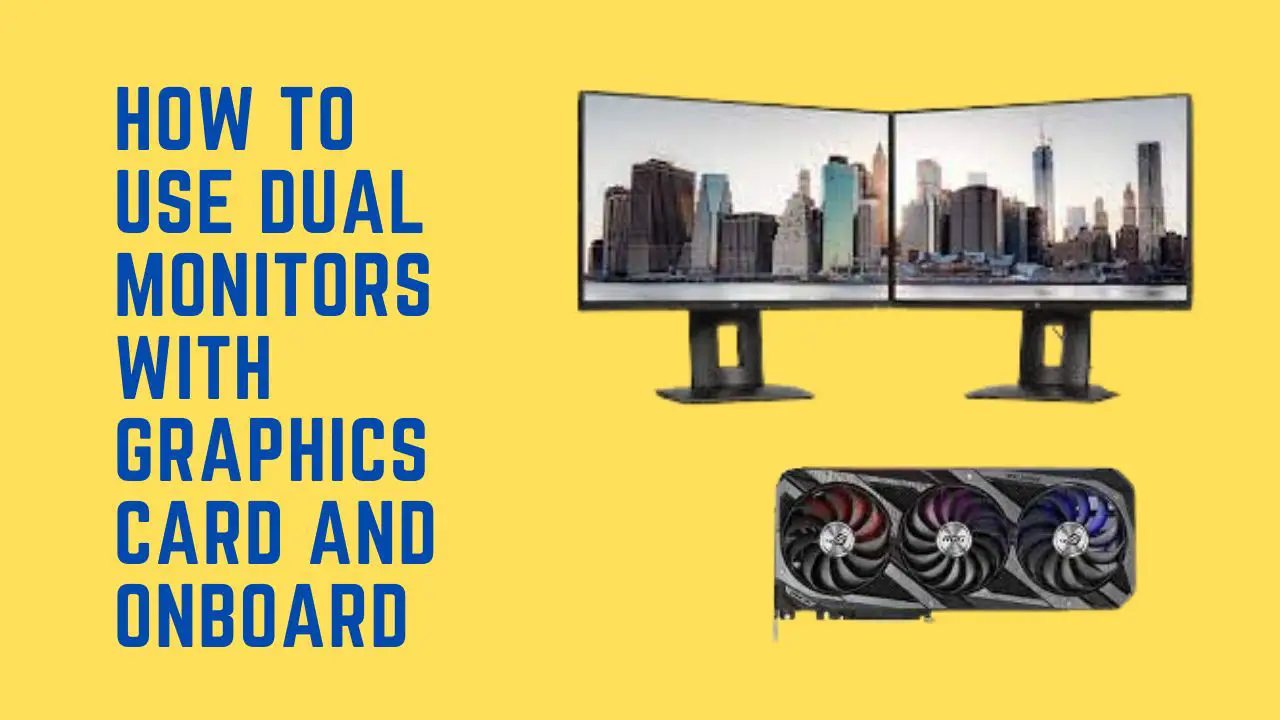Having a dual monitor setup is incredibly helpful for multitasking and productivity. But setting up dual monitors with graphics cards and onboard video seems challenging.
But with research and the right knowledge, I figured out how to use dual monitors with my graphics card and onboard.
After reading this article, you’ll soon have all the benefits of having two displays running simultaneously.
Let’s get started!
How to use dual monitors with a graphics card onboard?
It is how to use a dual monitor with an onboard graphics card.
1. Connecting onboard GPU
In order to connect dual monitors to a graphics card, firstly, you should connect the GPU to your computer.
You can connect the VGA, HDMI, and DVI cable to the computer. You may need an adapter to connect the onboard GPU if your monitor has none.
2. Configuring BIOS settings
After connecting the onboard graphic card, you must configure the BIOS settings to enable the dual monitors on a GPU.
In order to configure, you should turn off your monitor and then turn it on and press the F2 during the boot process to open the BIOS settings.
After accessing the BIOS settings, navigate to the integrated peripherals or onboard device section to enable the onboard graphic card.
3. Installing driver
After configuring the BIOS settings, you must download the appropriate driver to the onboard graphic card.
In order to download, go to the manufacturer’s website, download the compatible driver according to your monitor and onboard graphic driver, and install it into your pc.
4. Select monitor layout
After installing the compatible driver now, you will need to select the layout of your monitor for dual monitors.
In order to do it, right-click on the desktop, then select the display settings or screen resolution tab.
Now select extend your display across the multiple monitors or duplicate your display on both monitors option to connect the dual monitors.
5. Setting display configuration
After selecting your monitor layout, you will need to configure the display setting of each monitor.
To configure the display settings, right-click on the desktop, then select the display settings or screen resolution.
Then select the appropriate refresh rate and the resolution for each of the monitors or set it according to your needs or preference.
6. Maximize workflow
After configuring each monitor setting, you can enjoy your dual monitor setup with an onboard graphic card.
You can easily use dual or multiple windows at the same time without worrying about the large number of tabs in one window.
It will also increase the productivity and efficiency of your monitors. A dual monitor setup is also beneficial if you’re a gamer; you can see one image on the big display.
How to enable the dual monitor in the BIOS Gigabyte?
Gigabyte is a high-quality display, and its biggest and most efficient feature is that you can easily enable the dual monitor in the BIOS settings.
You can easily use the dual monitors at the same time without the usage of an extra pc. It is very useful if you’re a gamer, designer, or video editor.
In order to enable the dual monitors on your Gigabyte monitor:
1. First, turn off your computer, restart it and press the F2 or DEL to open the BIOS settings during the boot process.
2. After getting access to the BIOS settings, now navigate to the integrated peripherals or onboard devices tab to look to enable the onboard graphic card.
3. Now navigates to the integrated graphic configuration or integrated graphic section
4. Now ensure that the onboard graphic card is enabled
5. Then save the changes by clicking on the ok and exiting the BIOS settings
6. Now reboot your computer to detect the dual monitor setup
7. After rebooting your computer now, you can enjoy your dual monitor setup without the usage of extra pc
This process of the BIOS settings configuration depends on your monitor model, but usually, the process is the same for all monitors.
FAQ
Can you use dual monitors with integrated graphics and GPU?
It depends on your integrated graphic card; if your integrated graphic card supports the dual monitor setup, then you will not need any extra dedicated graphic card.
If your graphic card does not support dual monitors, you will need to use the additional GPU analogue side.
Should I plug my second monitor into my graphics card or motherboard?
If you have a dedicated graphics card, you can use the second monitor with your dedicated graphics card instead of plugging it into the motherboard.
Wrapping Up
It is the way to use dual monitors with a graphic card. You should try this way to use the dual monitor.
- Connecting onboard GPU
- Configuring BIOS settings
- Installing driver
- Select monitor layout
- Setting display configuration
- Maximize workflow
Setting up the dual monitor setup with the onboard graphic card is one of the easy ways to increase your monitor productivity and efficiency.
